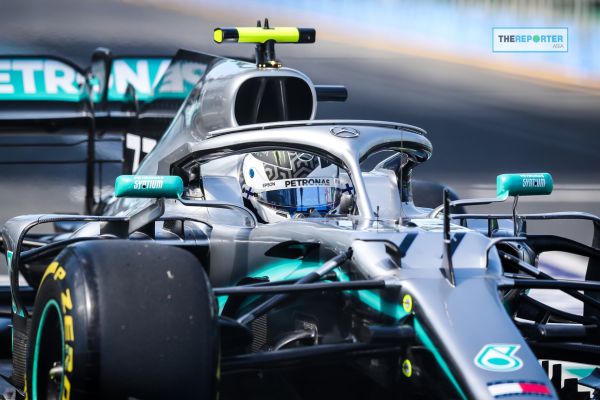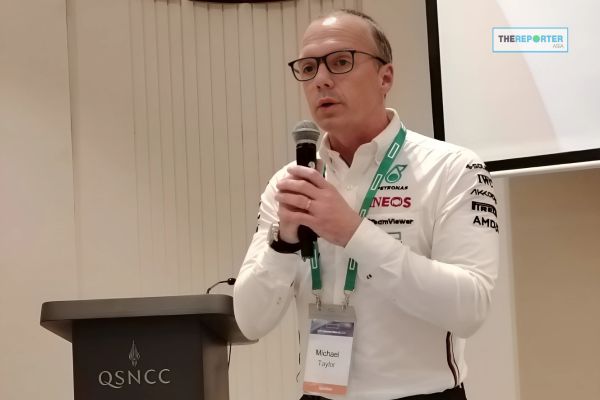Bangkok, Thailand – The Mercedes-AMG Petronas F1 Team reveals its winning strategy in Formula One racing through the use of cutting-edge technology, including high-speed big data analytics, advanced race simulation, and Digital Twin development to gain a competitive advantage.
- – HPE Teams Up with NVIDIA to Drive Private Cloud for AI
- – Tencent’s AI-Powered Business Solutions Take Center Stage at GDES 2024
Formula One racing is the pinnacle of motorsports, captivating over 1.4 billion viewers worldwide, with over 60 million viewers tuning in to live television broadcasts for each race. With 24 races throughout the season, the competition is fierce and demanding, especially with budget constraints on car development. This pushes teams to rely on cutting-edge technology to maximize performance.
Michael Taylor, IT Director of the Mercedes-AMG Petronas Formula One Team, gave an exclusive interview on the role of technology in driving the team’s success. He emphasized the importance of data analysis, race simulation, and Digital Twin development to enable the team to make fast, accurate, and efficient decisions. Taylor stated, “In the world of Formula One, every millisecond counts. We must utilize every available technology to gain a competitive edge.”
Delving into the 3 Winning Strategies of the Mercedes-AMG Petronas F1 Team:
1. High-Speed Big Data Analytics:
- F1 Cars: Sensor Hubs: In each race, the Mercedes-AMG Petronas team gathers massive amounts of data from over 300 sensors installed on the car, generating up to 7 billion data points. This data covers every aspect of the car’s performance, from speed, temperature, and pressure to vibration. This information is crucial for analyzing car performance and making strategic decisions.
- Data Transmission Speed is Crucial: To allow engineers to analyze data in real-time, the Mercedes-AMG Petronas team utilizes high-speed network technology like SD-WAN to transmit data from the race car back to the control center at the Brackley factory in England at maximum speed. This enables the team to make quick and accurate decisions. Taylor highlighted, “Throughout a race weekend, we generate millions of data points, requiring a significant number of personnel across various groups to view and analyze our data.”
- Detailed Analysis, Every Millisecond: Data sent back to the control center is meticulously analyzed by a team of expert engineers to gain a deep understanding of car performance, tire efficiency, and competitor behavior. The data is processed in real-time to allow for immediate strategy adjustments.
- Fast Decisions, Data-Driven: Real-time data analysis allows the team to make strategic decisions in a timely manner, such as tire changes, overtaking plans, and position defense, all of which are crucial factors influencing race outcomes.
- Digital Twin: Virtual Race Car: Furthermore, the data is used to develop a Digital Twin, a virtual replica of the race car, for testing and adjusting various settings before the actual race. The Digital Twin allows the team to visualize the car’s overall performance and fine-tune settings accurately without risking on-track experimentation.
2. Advanced Race Simulation:
- F1 Wind Tunnel: The Secret of Aerodynamics: The Mercedes-AMG Petronas team utilizes wind tunnels and Driver-in-Loop Simulators to test and optimize the aerodynamics of the race car. The wind tunnel uses a 60% scale model of the actual car, and usage time is regulated by the FIA to limit budgets.
- Real Experience Before Hitting the Track: The Driver-in-Loop Simulator is a technology that allows the team to test various car settings and gather feedback from drivers before the actual race. Drivers experience a virtual reality environment of the race track and can test drive the car with different settings to find the perfect balance. This reduces risks and increases confidence for the actual race.
3. Digital Twin Development:
- Digital Twin: Virtual Model for Real Victory: The Digital Twin is a virtual model of the race car, created from data collected from sensors, wind tunnels, and the Driver-in-Loop Simulator.
- Unlimited Testing: The Digital Twin allows the team to test various car settings without needing the physical car, saving time and budget. It also allows for unrestricted testing without worrying about damage to the actual car.
- Analyze and Adjust Before the Real Race: Moreover, the Digital Twin enables the team to analyze and address issues before the actual race, reducing the chance of errors and increasing the likelihood of victory.

Mercedes-AMG Petronas F1 Challenges and Technology Selection:
Taylor acknowledges the importance of selecting the right technology, especially with budget limitations. The Mercedes-AMG Petronas team prioritizes building relationships with leading technology partners like HP to acquire cutting-edge, reliable technology that meets the team’s needs. Notably, HPE Apollo 6500 has enabled the team to accelerate workflow, reducing pre-race simulation time from 3-4 days to less than 24 hours, allowing for more simulations during race weekends.
“In selecting technology partners, we don’t just look at the budget; we look for partners who truly understand and can meet our needs,” says Taylor.
The team also prioritizes personnel development to ensure they can utilize technology to its fullest potential, providing training and encouraging staff to continuously learn new technologies.
“We believe that people are at the heart of success, and technology is a tool that helps people work more efficiently,” adds Taylor.
“We believe that technology is the key to victory,” Taylor concludes.
In addition, Taylor emphasized the importance of collaboration between the IT team and the engineering team, stating, “The IT team and the engineering team must work closely together to ensure that the technology we use truly meets the needs of the engineering team.”
With a strategy focused on technology utilization and personnel development, the Mercedes-AMG Petronas Formula One Team has achieved continuous success, winning 8 Formula One World Championships.
“Our success is not due to luck, but to dedication, hard work, and the intelligent use of technology,” Taylor concludes.
#FormulaOne #MercedesAMGPetronas #SportsTechnology #DigitalTwin #DataAnalysis #Speed






